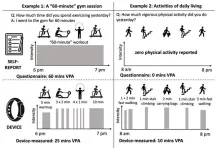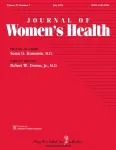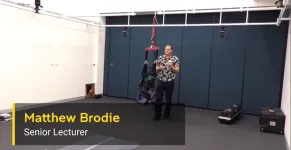(Press-News.org) In a series of three editorials published in the British Journal of Sports Medicine, the international team of scientists discuss issues facing the wearables field including lack of standardisation of devices and data, disconnects between research and industry and the impact of inequality in ownership.
Currently around a third of UK adults own a smartwatch or fitness tracker. A 2021 Australian-based survey reported 24 percent used fitness trackers and 23 percent used smartwatches.
Some use them to track their steps, others their sleep, but few understand the potential of these devices to transform our understanding of how everyday activity influences health.
“If you ask someone how much exercise they did today they will answer none if they missed the gym at lunchtime, but their fitness tracker may tell a very different story,” said Emmanuel Stamatakis, Professor of Physical Activity, Lifestyle and Population Health at the University of Sydney’s Charles Perkins Centre, who co-led the editorial series.
“The device will pick up the short bursts of physical activity, for example when they run for the train or powerwalk to work.
“The use of wearable devices in research, paired with rapidly developing AI, allows us to unlock how these micropatterns of daily activity relate to a person’s risk of premature death, cardiovascular disease and even cancer.
“It’s an exciting time to be working in this area of research.”
“We now understand that the relationship between physical activity and health is much stronger than previous studies based on self-reported data suggested,” adds series co-lead Jason Gill, Professor of Cardiometabolic Health at the University of Glasgow.
“It is important to harness the capabilities of wearables as research tools because they have so much potential to inform guidelines for how much and what types of activity we recommend people undertake to improve their health, as well as providing new approaches to help support to people to become more active.”
But the field doesn’t come without its challenges – all exacerbated by the pace of this technology.
“The research cycle can be slow but that’s not an option here. We have to adapt and move quickly if we are going to make the most of the opportunities wearables present - or be prepared to miss the train, ” said Professor Stamatakis, who is also launching the Mackenzie Wearables Research Hub at the Charles Perkins Centre, University of Sydney, Australia this week.
Key challenges
Standardisation of data and devices
While individuals tracking their own activity use consumer devices like Fitbit or Garmin, most research studies use research-grade accelerometers due to their consistency and scientifically documented properties. Consumer devices operate on proprietary algorithms that are “black boxes” to scientists. There is also a lot of variation between brands and models, frequent model updates, and strict corporate rules around data ownership and privacy.
The researchers suggest industry and academics will need to work together a lot more closely on consistency around capabilities and activity metrics for consumer wearables to become a valid source for research measurement and monitoring of health behaviours at a population level.
Barriers to use in health care
“There is immense potential for data from wearable devices to inform clinical decisions about risk, diagnosis and treatment. This is particularly relevant in cardiology because low physical activity increases risk of many heart diseases, while once disease develops it reduces the ability to be active,” said Professor Tim Chico from the University of Sheffield, lead author on the editorial on device-based measurement of physical activity in cardiovascular healthcare.
However, despite the hundreds of device models currently in use, very few are approved for clinical use by regulators. The authors write that incentives for manufacturers to obtain such expensive approvals are small compared with direct sales as “well-being tools.”
The range of measures and accuracy of devices is also a concern in this context, as is the need to have data available to health professionals at the point of decision-making. This raises other questions about the transfer of data from individuals’ devices to their medical records, security and privacy protection, as well as IT capabilities – particularly in less developed nations.
Regulatory frameworks have not adapted to the very fast pace of wearables and big data evolution.
Inequity in ownership and use
Ninety-three percent of people in the UK and around 90 percent of Australians own a smartphone capable of counting steps which presents huge opportunities for public health.
Tracker and smartwatch use is also growing exponentially, however, there are distinct socioeconomic inequalities in ownership. This presents a problem for using consumer wearables to support positive behaviour change. While people in lower socioeconomic groups are at higher risk of lifestyle-related chronic disease and may have the most to gain from such behaviour change, the purchase of these devices could be well outside their means.
Opportunities
The researchers suggest that none of these challenges are insurmountable.
They argue that better integration of wearables in randomised controlled clinical trials and cohort studies is drastically needed. They suggest that regulators consider the approval of select devices as add-ons to standard care and that industry and academia work more closely together to maximise the potential of wearables for chronic disease diagnosis, prevention and treatment – with the ultimate goal of a happier and healthier population.
-ENDS-
END
The Persian Gold Tarantula (Chaetopelma persianum) is a newly described species recently discovered in northwestern Iran. In fact, the “woolly, golden hairs” the scientists observed and examined on a single specimen, were one of the features so unique that it was not necessary for additional individuals to be collected and physically studied. It was clear enough that it was a species previously unknown to the scientific community.
The paper, authored by Iranian arachnologist and taxonomist Dr Alireza Zamani (University of Turku, Finland) and his Canadian colleague Rick C. West, was published in the peer-reviewed, open-access scientific journal ZooKeys on the observance ...
TUSCALOOSA, Ala. – A lack of time management skills, particularly in organization, can lead to poor sleep quality for college students according to research conducted at The University of Alabama.
Dr. Adam Knowlden, associate professor of health science with the UA College of Human Environmental Sciences, investigated time management and how it influences sleep health in full-time college students in the areas of setting goals and priorities, mechanics of time management, and preference for organization.
“College students tend to deal with lifestyle-related sleep problems,” said Knowlden. “For example, balancing academic and social ...
A new study has shown that among incarcerated women, many have to trade or barter to access menstrual hygiene products. The study, which examines menstrual equity, or the access to menstrual products and safe menstruating environments, in the criminal legal system, is published in the peer-reviewed Journal of Women’s Health. Click here to read the article now.
Patricia Kelly, PhD, from Thomas Jefferson University School of Nursing, and coauthors, found that 53.8% of women involved in the criminal legal system received less than five menstrual ...
(COLUMBUS, Ohio) – In a landmark moment for the Abigail Wexner Research Institute at Nationwide Children’s, a 5-year-old from Bellefontaine, Ohio, received the first dose of a recently approved gene therapy for Duchenne muscular dystrophy at Nationwide Children’s Hospital, where the therapy was invented and initially tested. The therapy, developed, tested and patented at Nationwide Children’s marks an extraordinary achievement in the field of neuromuscular medicine and provides a life-altering treatment for children with Duchenne muscular dystrophy. This is the second gene therapy developed at Nationwide Children’s to receive FDA approval, two ...
Safe drinking water is threatened globally by the increased toxicity of phytoplankton — or microscopic algae — blooms.
The need for a better understanding of when and where the blooms will emerge spurred Virginia Tech researchers to start developing the first automated, real-time lake phytoplankton forecasting system. Working with the University of Florida, Virginia Tech faculty have been awarded a $2.2 million National Science Foundation grant as one of 12 projects funded by the foundation's new Using the Rules of Life to Address Societal Challenges program.
"The enormous opportunity to apply biological principles to ...
In-water monitoring by the Australian Institute of Marine Science (AIMS) shows hard coral cover across the Great Barrier Reef remains at similar levels to that recorded in 2022, with small decreases in the Northern, Central and Southern regions.
Published today (Wednesday 9 August), AIMS’ Annual Summary Report on Coral Reef Condition for 2022/23 found that while some reefs continued to recover, their increased hard coral cover was offset by coral loss on other reefs. Most reefs underwent little change in coral ...
When it comes to college-aged adults who are glued to their smartphones, experts argue over whether texting while walking increases the risk of an accident. Some studies have shown that texting pedestrians are more likely to walk into oncoming traffic, while other studies suggest that young adults have mastered the art of multitasking and are able to text accurately while navigating obstacles. However, few studies have measured how texters respond to unpredictable hazard conditions. By simulating an environment with random ...
About The Study: Among 98,000 postmenopausal women, compared with consuming three or fewer servings of sugar-sweetened beverages per month, those who consumed one or more sugar-sweetened beverages per day had a higher incidence of liver cancer and death from chronic liver disease. Future studies should confirm these findings and identify the biological pathways of these associations.
Authors: Xuehong Zhang, M.B.B.S., Sc.D., of Brigham and Women’s Hospital and Harvard Medical School in Boston, is the corresponding author.
To access the embargoed study: Visit our For ...
Toronto, ON, August 9, 2023 – Autistic females (assigned sex at birth) have an 83% increased risk of self-harm leading to emergency healthcare relative to non-autistic people, according to a new study from ICES and the Centre for Addiction and Mental Health (CAMH).
Autistic males also had a 47% greater risk of self-harm events and had the highest incidence of suicide death compared to autistic females and non-autistic individuals.
The study, “Self-Harm Events and Suicide Deaths Among Autistic Individuals in Ontario, Canada,” was published today in JAMA Network Open ...
About The Study: The findings of this study suggest that the expertise and resources that accompany high-volume treatment facilities are associated with improved outcomes for men with very high-risk prostate cancer, but further investigation is needed to identify the specific causes for this association.
Authors: Sagar A. Patel, M.D, of Emory University in Atlanta, is the corresponding author.
To access the embargoed study: Visit our For The Media website at this link https://media.jamanetwork.com/
(doi: ...








